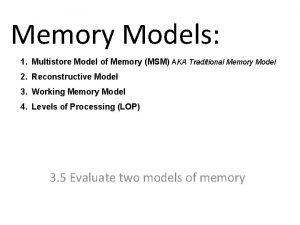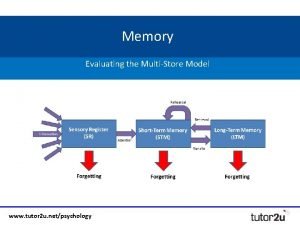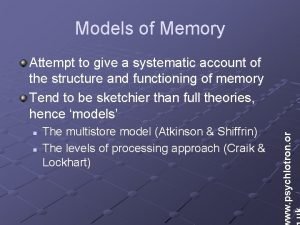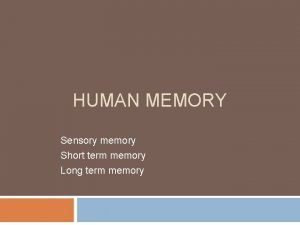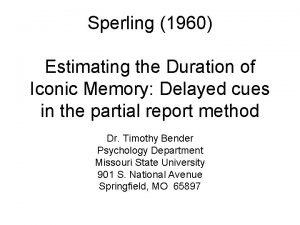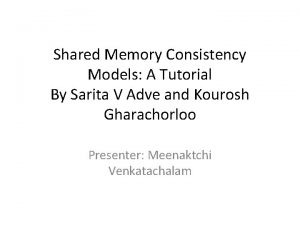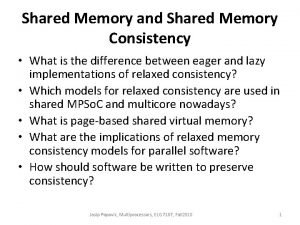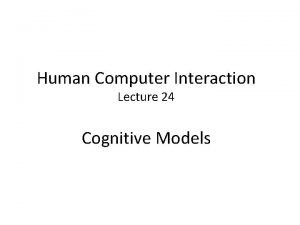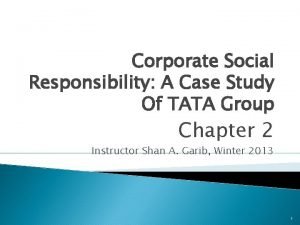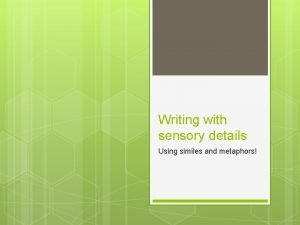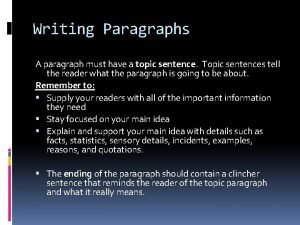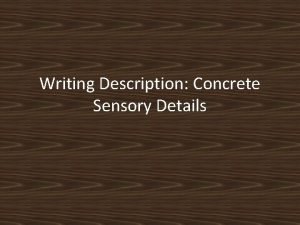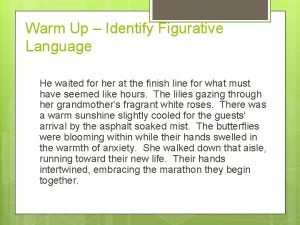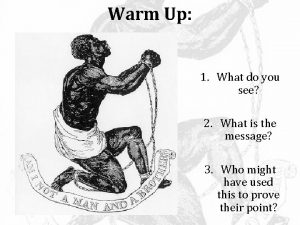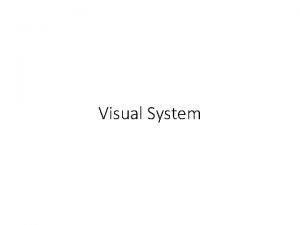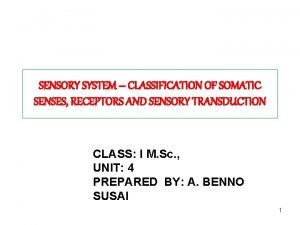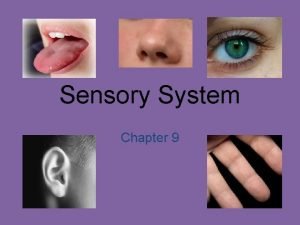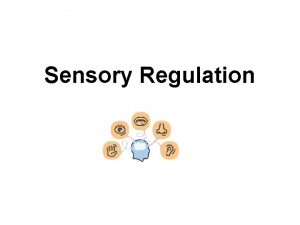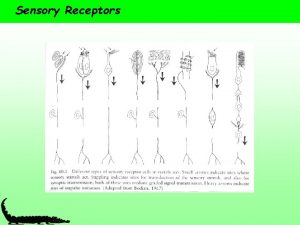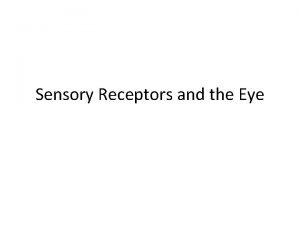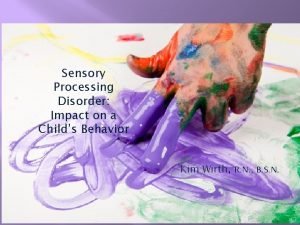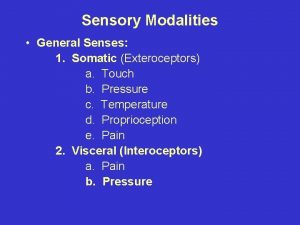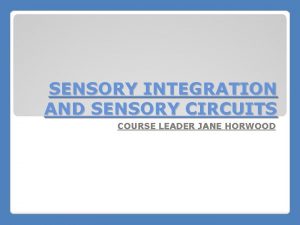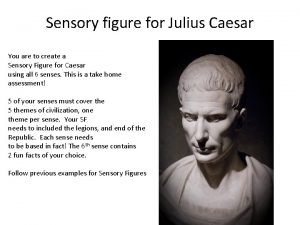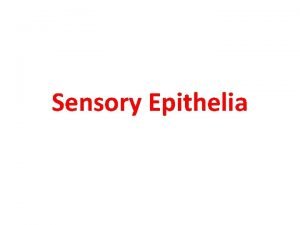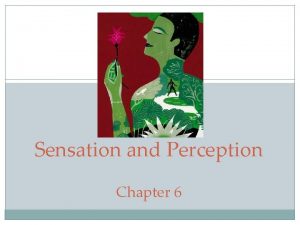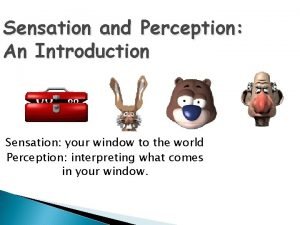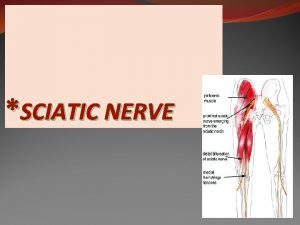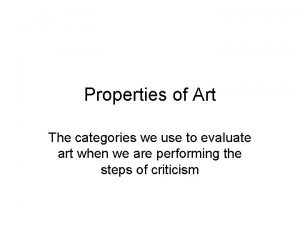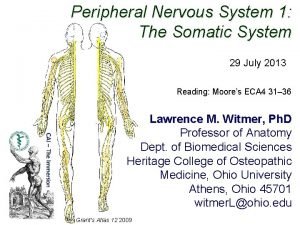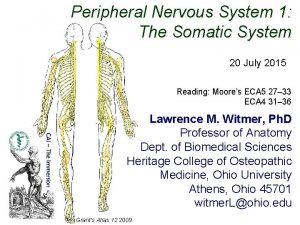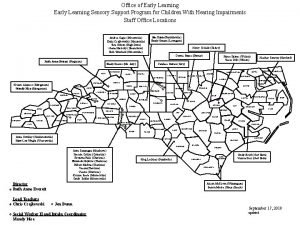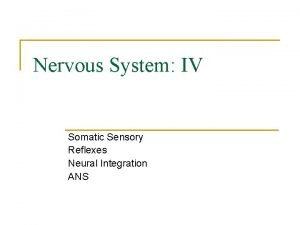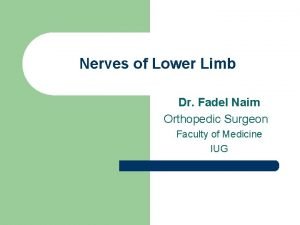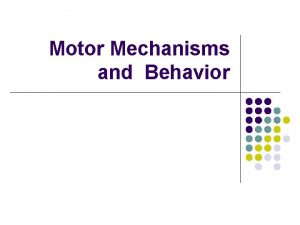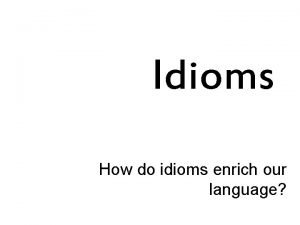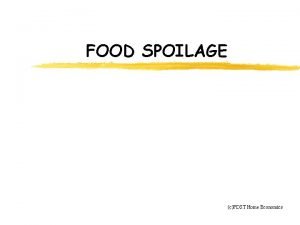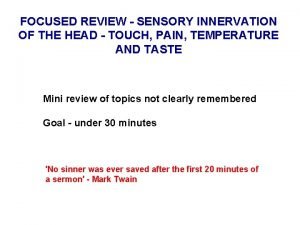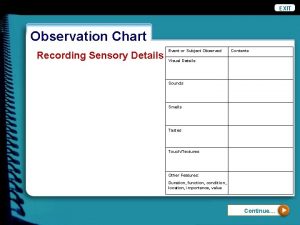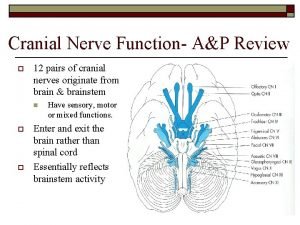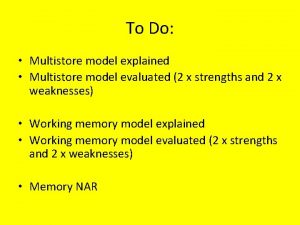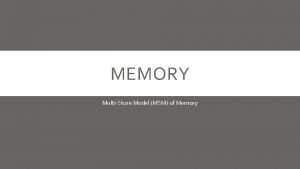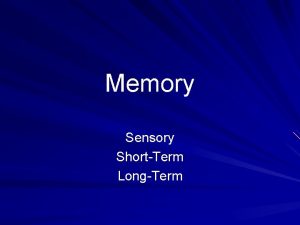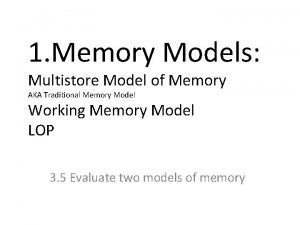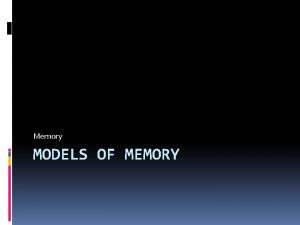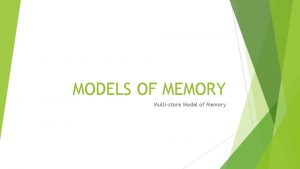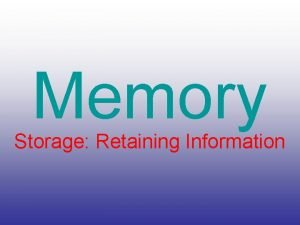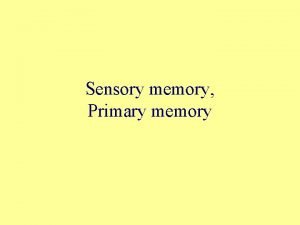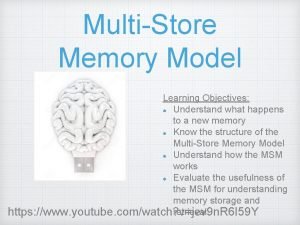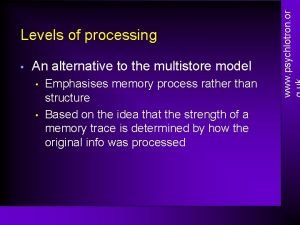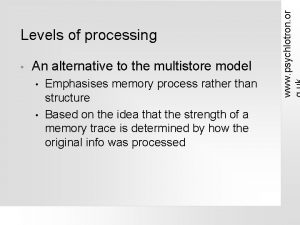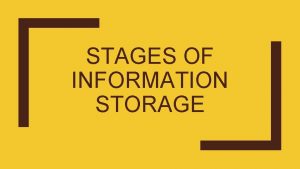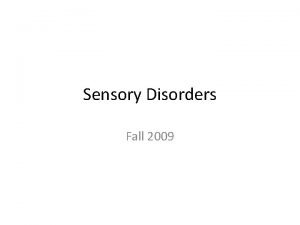Models of memory MultiStore Model Sensory Memory ShortTerm






































































- Slides: 70

Models of memory Multi-Store Model Sensory Memory Short-Term Memory Long-Term Memory Working Memory Model Central Executive Phonological Loop Episodic Buffer Visuospatial Sketchpad Memory Processing Levels of Processing Implicit/Explicit

�Schema Theory Influence on memory encoding, storage, and retrieval Automatic and non-conscious but can lead to biases in and errors in thinking and memory processes Can include but not limited to: �Top down & bottom up processing �Pattern recognition �Effort after meaning �Stereotyping

� Reliability of Cognitive Processes Reconstructive Memory �Confabulation �Schema Processing �False Memories

�Essentially – thinking, problem solving, perceptions, emotions, memories, language etc. processed in your brain 4

� The cognitive approach to understanding behaviour looks at: �cognitive processing (SL and HL) �reliability of cognitive processes (SL and HL) �emotion and cognition (SL and HL) �cognitive processing in the digital world (HL only). �Relevant to all the topics are: �the contribution of research methods used in the cognitive approach to understanding human behaviour �ethical considerations in the investigation of the cognitive approach to understanding human behaviour. 5

� Schemas are a way to score knowledge � Schema Theory is a cognitive theory about information processing � People don’t passively accept info � They interpret and integrate info to make sense of their experiences � Can be an unconscious process


Schemas are mental molds into which we pour experiences. 8

� In psych, many theories/studies support this � Most theorize our human schemas develop very early in life, infant cognition begins immediately � Often measured and understood through studying language and grounded in the cultural components language transmits � We’re starting with schema & memory though and will revisit language soon 9

Definition Memory is any indication that learning has persisted over time. It is our ability to store and retrieve information. 10

Keyboard (Encoding) Disk (Storage) Sequential Process Monitor (Retrieval) 11

The Atkinson-Schiffrin (1968) three-stage model of memory (aka multi-store model) includes a) sensory memory, b) short-term memory, and c) long-term memory. But it’s now considered an outdated model, most significant for the subsequent research it spawned 12



u I’m going to show you a list of words. u When you see the recall slide, write down as many as you can, order is not important.


bed

night

rest

awake

toss

tired

dream

wake

night

snooze

blanket

doze

artichoke

slumber

snore

turn

nap

peace

yawn

drowsy

night


u Recall


� We are more likely to remember things at the beginning or end of a series – how many of you remembered bed, rest, awake or peace, yawn, drowsy? �Glanzer & Cunitz (Primacy-Recency) Serial Position Effect � Unusual or remarkable things though stand out – how many had “artichoke”? � Repetition leads to higher recall as well - how many remembered “night”? � Chunking – who remembered “toss” & “turn”? � Déjà vu – how many of you remembered sleep? � One more exercise – get in a circle � This is called the next-in-line effect

u bed u wake u snore u night u turn u rest u snooze u nap u awake u blanket u peace u toss u doze u yawn u tired u artichoke u drowsy u dream u slumber u night

1. 2. 3. Some information skips the first two stages and enters long-term memory automatically. - Space - Time - Frequency - Images Let’s do an example with images Since we cannot focus all the sensory information in the environment, we select information (through attention) that is important to us. - Nose - Tongue - Pants The nature of short-term memory is more complex. 43

Alan Baddeley (2002) proposes that working memory contains auditory and visual processing controlled by the central executive through an episodic buffer. 44

� Moonwalking Einstein � Michael Cole with

46

� No clear indication of where or how any of this stuff works � Hippocampus and synapses are involved as is the cortex, amygdala, both hemispheres etc.

Nerves consist of neural “cables” containing many axons. They are part of the peripheral nervous system and connect muscles, glands, and sense organs to the central nervous system. 48

The body’s information system is built from billions of interconnected cells called neurons. Estimated that there are b/w 10 -100 billion that can make 13 trillion connections 49

A nerve cell, or a neuron, consists of many different parts. 50

� Neurotransmission is the process by which messages are sent between neurons � When an individual neuron “fires” it is called an action potential – it’s an all or nothing response – it either fires or doesn’t

Refractory Period: After a neuron fires an action potential it pauses for a short period to recharge itself to fire again. 52

53

A junction between the axon tip of the sending neuron and the dendrite or cell body of the receiving neuron. This tiny gap is called the synaptic gap or cleft. 54

Neurotransmitters (chemicals) released from the sending neuron travel across the synapse and bind to receptor sites on the receiving neuron, thereby influencing it to generate an action potential. 55

Neurotransmitters bind to the receptors of the receiving neuron in a key-lock mechanism. 56

57

58

Neurotransmitters in the synapse are reabsorbed into the sending neurons through the process of reuptake. This process applies the brakes on neurotransmitter action. 59

Neurotransmitter Acetylcholine Dopamine Endorphins Norepinephrine Serotonin Function(s) Enables muscle action, learning & some memory (muscle memory - more specifically, habits) Influences voluntary movement, learning, feelings of pleasure Painkillers, lead to feelings of euphoria Alertness & arousal – stimulates sympathetic nervous system Affects mood, hunger, sleep, and arousal (primary drives) – 60

� Acetylcholine and Memory in rats � Aim: to determine how blocking the acetylcholine receptors or reuptake in the brain affects spatial memory � Procedure: Rats learned to navigate a maze � Block ACh in 1 group of rats with scopolamine, prevent its reuptake in group 2 with physostigmine, and control group 3 � Results: Group 1 slowest at going through maze; Group 2 faster than both other groups and fewer mistakes

Acetylcholine and Memory in humans � Aim: to determine how blocking the acetylcholine receptors in the brain affects spatial memory � � Procedure: 20 male students were injected with either scopolamine or a placebo and then placed in an f. MRI scan while playing the "Arena task. " Once the students found the pole, the screen went black, and the game started over. � Results: The scopolamine group took longer and made more mistakes the second time and had significant reduction in hippocampus use. Acetylcholine plays a key role in the encoding of spatial memories.

FUNCTION REWARD CENTER - James Olds (1950’s) Rats cross an electrified grid for self-stimulation when electrodes are placed in the “reward center” called the Nucleus Accumbens 63 Sanjiv Talwar, SUNY Downstate - Robert Heath (1950’s) – similar research on humans (no shock grid) , patients push button themselves – B -19 did it 1500 times in 3 hours to the point of euphoria. Disconnected despite his protests. Pg. 44 Companion

� It is reductionist to suggest that complex behavior is a product of the right mix of chemicals in our brains � Neurotransmission plays a role but cannot explain behavior alone � Read Purple Book 46 -48 Effects of Nt on Behavior

�Think about our sleep serial position effect, we fill it in with schema �Bartlett – reproductive vs. Reconstructive �Thanks for the Memories reading too �Let’s try another example �Watch the following video – Brain Games

� How many people were involved in the confrontation? � What color was the woman’s jacket? � What color was the thief’s hoodie? � What did the thief take from the old man? � Did you see thief drop anything? � What was the victim saying? � Do you think you could pick the perpetrator(s) out of a lineup? � Describe the perpetrator(s) as much as you can

u Eyewitness identification evidence is the leading cause of wrongful conviction in the United States.

u Of the more than 200 people exonerated by way of DNA evidence in the US, over 75% were wrongfully convicted on the basis of erroneous eyewitness identification evidence.

u Facilitated the exoneration of 351 people who were convicted of crimes they did not commit, as a result of faulty eyewitness evidence (as of 2017). u A number of these cases have received attention from the media.

u Loftus!
 Multistore memory model
Multistore memory model Tutor 2 net
Tutor 2 net Multistore model
Multistore model Wickens et al fruit meat and professions
Wickens et al fruit meat and professions Shortterm housing
Shortterm housing Sensory memory example
Sensory memory example Sperling iconic memory
Sperling iconic memory Semi modals examples
Semi modals examples Shared memory consistency models: a tutorial
Shared memory consistency models: a tutorial Intel processor
Intel processor Semantics prototype
Semantics prototype Implicit memory vs explicit memory
Implicit memory vs explicit memory Long term memory vs short term memory
Long term memory vs short term memory Internal memory and external memory
Internal memory and external memory Primary memory and secondary memory
Primary memory and secondary memory Physical memory vs logical memory
Physical memory vs logical memory Which memory is the actual working memory?
Which memory is the actual working memory? Virtual memory and cache memory
Virtual memory and cache memory Virtual memory in memory hierarchy consists of
Virtual memory in memory hierarchy consists of Eidetic memory vs iconic memory
Eidetic memory vs iconic memory Symmetric shared memory architecture
Symmetric shared memory architecture Model-netics 151 models
Model-netics 151 models Types of cognitive models in hci
Types of cognitive models in hci Ackerman's model of csr
Ackerman's model of csr Multiple nuclei model
Multiple nuclei model Metaphor is
Metaphor is How many sentences does a paragraph have
How many sentences does a paragraph have Sensory details definition
Sensory details definition Sensory ethnography
Sensory ethnography What does sensory language mean
What does sensory language mean Sensory figure of harriet
Sensory figure of harriet Photoreceptor transduction
Photoreceptor transduction The hot july sun beat relentlessly down
The hot july sun beat relentlessly down Structure of the sensory system
Structure of the sensory system Classification of somatic senses
Classification of somatic senses Sensory system organs
Sensory system organs Sensory cup analogy
Sensory cup analogy Transduction of hearing
Transduction of hearing Classification of sensory receptors
Classification of sensory receptors Exteroceptors
Exteroceptors Sensory processing disorder dsm
Sensory processing disorder dsm Tina champagne trauma informed care
Tina champagne trauma informed care Exteroceptors examples
Exteroceptors examples Sensory symptoms
Sensory symptoms Types of sensory disorders
Types of sensory disorders Sensory input integration motor output example
Sensory input integration motor output example Sensory figure
Sensory figure Sensory epithelia
Sensory epithelia Sensory adaptation definition
Sensory adaptation definition Signal detection theory example
Signal detection theory example Sciatic nerve motor or sensory
Sciatic nerve motor or sensory Technical properties of art
Technical properties of art Visceral vs somatic sensory
Visceral vs somatic sensory Erb palsy
Erb palsy Unpleasant sensory and emotional experience
Unpleasant sensory and emotional experience Early learning sensory support program
Early learning sensory support program Location of sensory neurons
Location of sensory neurons Posterior cutaneous nerve of thigh
Posterior cutaneous nerve of thigh Sensory and motor mechanism
Sensory and motor mechanism Sensory language definition
Sensory language definition Indication of crutches
Indication of crutches Food star diagram
Food star diagram Causes of food spoilage
Causes of food spoilage Sensory innervation of nose
Sensory innervation of nose Auditory sensory
Auditory sensory What is sensory observation chart
What is sensory observation chart Autonomy vs shame
Autonomy vs shame Metaphor in house on mango street
Metaphor in house on mango street Definition of sensory language
Definition of sensory language Cranial nerves sensory or motor or both
Cranial nerves sensory or motor or both Vestibulocochlear nerve test
Vestibulocochlear nerve test
